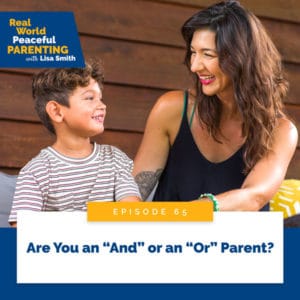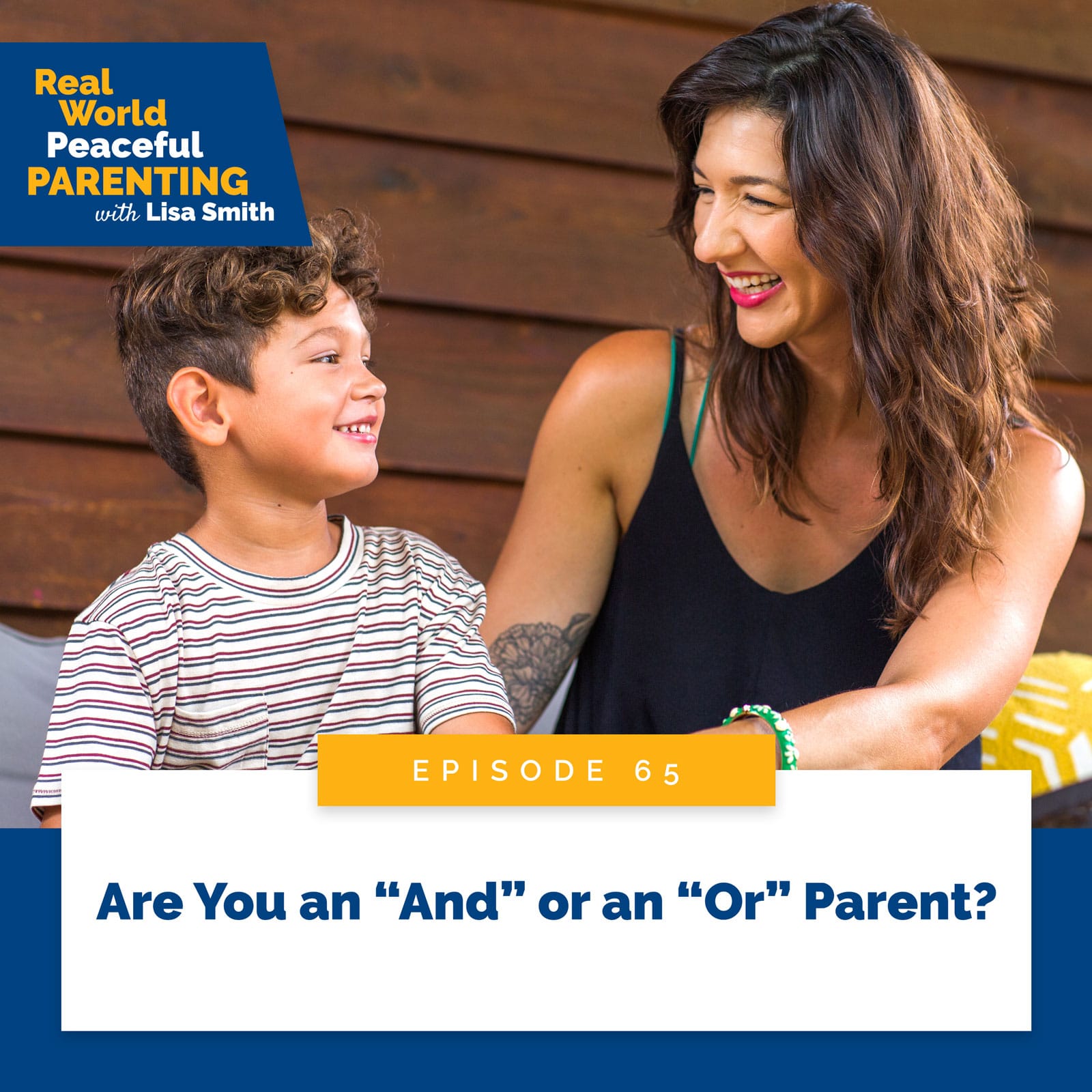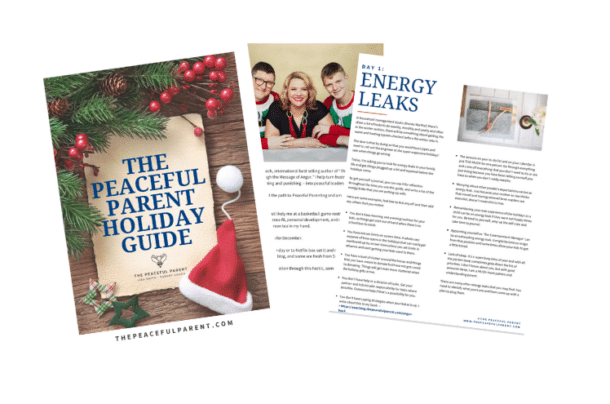 How often do you have all or nothing thoughts like “I’m getting it right or I’m messing it up,” “I’m a good parent or a bad parent,” or “I’m right, or they’re right?” Parenting doesn’t have to be an and/or situation; we don’t have to choose. Real-world peaceful parenting is about synchronicity.
How often do you have all or nothing thoughts like “I’m getting it right or I’m messing it up,” “I’m a good parent or a bad parent,” or “I’m right, or they’re right?” Parenting doesn’t have to be an and/or situation; we don’t have to choose. Real-world peaceful parenting is about synchronicity.
So many people believe that as parents, they need to be perfect. They think that they can’t make mistakes, and things are either one way or the other. But synchronistic thinking as an intentional parenting tool has so many benefits for you and your kids.
In this episode, I’m showing you how to transition from being an and/or parent and feel the benefits and value of synchronicity. I’m sharing what synchronistic thinking is, some examples of synchronistic thoughts, and showing you how to use them to create connection in your parenting. Discover how to recognize where you are choosing between and/or and move towards synchronicity in your relationships.
Is there sibling rivalry, name-calling, and not getting along in your home and you don’t know what to do about it? Can you imagine if sibling fighting was no more? I’m here to help. On Thursday, April 7th at 9am PT, 10am MT, 11am CT or 12pm ET, I’m running the Sibling Fighting live workshop where I’ll be covering why this happens, what does and doesn’t work in resolving it, and when to step in to work it out. And if you can’t make it live, no problem! When you sign up you’ll get lifetime access to the recording. Click here to find out more and save your spot, I can’t wait to see you there.
What You’ll Learn from this Episode:
- One of the best ways to create connection with your children.
- A practical tool that can help you become a better parent.
- What your children can learn from you making mistakes.
- The impact that synchronicity can have upon your relationships with your family.
- How being an “and” parent has completely transformed my parenting.
- Why parenting doesn’t involve perfection.
- The benefits of modeling imperfection to your children.
Listen to the Full Episode:
Featured on the Show:
- Click here to sign up for my free Peaceful Parenting mini-course! You’ll find everything you need to continue on the path to peaceful parenting over there just waiting for you.
- If you have a suggestion for a future episode or a question you’d like me to answer on the show, email us or message us on Instagram
Full Episode Transcript:
Welcome to Real World Peaceful Parenting, a podcast for parents that are tired of yelling, threatening, and punishing their kids. Join mom and master certified parent coach Lisa Smith as she gives you actionable step-by-step strategies that’ll help you transform your household from chaos to cooperation. Let’s dive in.
Welcome, welcome, welcome. Welcome to today’s episode. Today I want to talk about becoming an and not an or parent. What Lisa? I know, I know. Hang with me though. It’s good stuff.
Now, today, we need to start out by acknowledging there is no perfection in parenthood. None. Not for any of us. I 100% Promise. Let me say that again. There is no perfection in parenthood. We get to be human as we’re parenting because we are human, and we all make mistakes. Every single one of us. I know this with 100% certainty because it’s part of the human experience.
So as parents, we get to lose our cool once in a while and navigate repair. We get to model imperfection so our kids know mistakes are part of the human experience. However, please, I beg you to hear this. Please. Ready? If you weren’t a perfect parent today, you aren’t failing. If you weren’t a perfect parent yesterday or last week, you aren’t failing. As a parent or as a human.
Really, it’s true. You can still foster connection in the face of imperfection. I do it all the time. Connection allows your child to know that he, she, or they are safe and loved even when you’re mad, sad, or happy with them. It’s the you’ve got this, and we’ve got your back on this journey. I feel like I need to say that again. Connection allows your child to know that he, she, or they are safe and loved even when you’re mad at them, sad about something they did, or unhappy with them. What we want our kids to know is you’ve got this, and we’ve got your back on this journey.
As a parent, I want you to hear this. You’re doing enough. You’re good enough. I want you to know that rupture and repair is part of a healthy relationship. Conflict is growth trying to happen. Imperfection, the rupture, and then a repair is a part of any healthy relationship, including the one you have with your children.
So your goal is not to aspire or demand that you be a perfect parent. The goal is to be a safe parent, a better parent, an open parent. Yeah? I want to say that again. The goal is not to be a perfect parent. You can’t shame or guilt or demand yourself into being one, by the way. The goal I want you to have for yourself is to be a safe parent, a better parent, an open parent.
So the goal is not perfect parenting. The goal is to create a safe atmosphere. The goal is to keep improving what you’re doing by showing up here every week listening to this podcast and taking other actions. The goal is to be open to change and new ideas, and to say I’m sorry when I get it wrong. To repair the rupture once it happens. Yeah?
Now listen, I am sure that even Mr. Rogers lost dishes every now and then. Yep, I didn’t know him, but I say this with 100% certainty. Well, how do you know then Lisa? Well, because we all mess up once in a while, all of us. You can mess up and repair with your kids. You can say I’m so sorry I lost it, and I yelled at you, sweetheart. Buddy, I was feeling frustrated and I yelled. The repair looks like, buddy next time I’ll try to take a couple deep breaths and calm my body before speaking when I’m frustrated. I love you always.
Yeah? Ah, so good. When you’re connected with your kid, it allows for your kid to learn emotional regulation with the security of knowing they’re safe even when their parents lose their cool. Let me say that again because I really, really, really want you to hear this and have an ah-ha moment. When you are connected with your kid, it allows for your kid to learn emotional regulation with the security that they’re safe even while their parent loses their cool. Cool, right? That makes me laugh.
This is one of the goals of peaceful parenting is for your kid to learn emotional regulation and know they’re safe, even while their parents is upset, right. When the parent loses their cool, the kid doesn’t fear retribution, punishment from that anger, trauma, something bad happening.
When you’re practicing peaceful parenting and when you’re connected with your kid, it allows your kid to learn emotional regulation, which means they’re staying calm. They’re learning to not storm. They’re learning to recognize the feelings and needs are underneath the storming. It allows them to learn that while knowing they’re safe, even while you’re upset, mad, sad, disappointed, frustrated, angry.
Oh, I want that. I want that right there, that sentence, I want that for every single child roaming the earth. I want that. I want that for your kids. I want that for you. That’s my goal in showing up here every week, if I’m honest, is to help you with the tools, support, ideas, and coaching that allow you to connect with your kid or kids in a way that teaches your kid emotional regulation with the security that they’re safe, even while you’re dysregulated, storming, and losing your shiz. Ah, so good.
That connection breeds security, attachment, confidence, and emotional regulation. The child learns to feel safe, learns emotional regulation, self-esteem, trust, and calm. As I said, I want that for you and your kids. Each and every one of you.
For us parents, one of the best ways I know to create the connection on our end is to think and not or. Say what Lisa? Yep. It’s as simple as and not or. Let me ask you. Do you or have you had painful thoughts like I’m either getting it right, or I’m messing up. I’m a good parent, or I’m a bad parent. I’m constantly asking myself for the and in my parenting. Let me explain.
I used to be an or person. This or that. Good or bad. On point or not. Failing or getting it right. He was right or I was right. I want to offer this to you today as one of our practical tools for 2022, you know, the year of becoming a better parent. The tool is to start thinking about and as a connection tool in your parenting.
As a side note, this works for other relationships too. For many of us, our brains don’t know that two things can be equally true. It’s called synchronous. Synchronous or synchronicity is defined as existing or occurring at the same time. When parenting thinking in a synchronistic way is useful, helpful, and regulating.
Synchronistic thinking can keep you from judging your kids, yourself, and others because it isn’t an either or. No one wins or loses. No one is all right or all wrong. No one is good or bad. Synchronistic thinking helps you recognize your own triggers, and helps you not storm alongside your kids.
Synchronistic thinking as an intentional parenting tool allows you to manage big emotions, both yours and your kids. It allows you to be comfortable with being uncomfortable. It allows you to feel your feelings and understand your kid’s feelings. It allows you to have your feelings and have empathy for others. It allows you to stay calm and rational. It allows you to be creative with solutions and limits.
So now maybe you’re thinking, “Okay Lisa. I’m on board with all this, but what exactly does it look like?” Ah, so glad you asked. Here’s some examples of things that can be synchronistic or equally true.
I can make a mistake and still be a good parent. I can do my best and know that’s enough. I can be strong and still need help. I can love my toddler and still want some alone time. I can learn from others and do what I think is right. I can be imperfect and be exactly what my child needs.
Some more examples of synchronistic parenting look like this. You can feel both grateful for your parenting journey and ready for a break. You can be proud of yourself for learning how to meet your kids needs and be exhausted by the day to day activities of meeting those needs.
Synchronistic parenting allows you to be comfortable in your parenting style, and still look for help and new ideas. Synchronistic parenting can allow you to be happy or pleased or proud that your child feels safe enough to share big emotions with you and be drained from helping him or her navigate those emotions all day.
Parenting doesn’t have to be an or situation. We don’t have to choose one position over the other. Real world peaceful parenting is about synchronicity. As I mentioned earlier, synchronicity is defined as existing or occurring at the same time. There’s so much relief in the idea that all of our thoughts and feelings can coexist. Can you feel it? Can you feel the value of transitioning from an or to an and parent?
I can understand that my kid’s melting down and still not like it. I can give my kids some screentime each day and not be sure that it’s the right thing to do. I can ask my son to put the dishes away and understand that he really doesn’t want to do it. It’s such a simple tool transitioning from or to and. It has completely transformed my parenting being an and parent.
It allows me to show up in a way that gives everyone permission to have their feelings. I can be totally pleased that I’m not putting the dishes away because I don’t like doing it and completely understand that my kid doesn’t like doing it, but he’s still going to do it. Those different feelings can all coexist in the same room. They can occur at the same exact time. I can make a mistake in my parenting and still believe I’m a good parent.
If I make a mistake and lose my shiz one day, I get dysregulated. I get triggered, and I have a little outburst of emotions. It doesn’t have to be an or. Op, I made a mistake and therefore now I’m a horrible parent. I can make a mistake and still be a good parent.
I can love my toddler and still want some alone time. I can be imperfect and be exactly what my child needs. I can be totally pleased that I’ve worked on building that connection with my child that he or she feel safe to let it all hang out after school with their big emotions, the after school meltdown, and be drained at the end of the evening from a long day of helping my six year old storm after school.
Synchronicity is defined as occurring at the same time. There’s so much relief in this concept, in this idea. It takes us completely out of the idea or out of the concept that we’re good or bad. That we’re getting it right or messing it up. Oh, it’s a complete game changer in peaceful parenting. I promise you.
What I want us to do here in the real world peaceful parenting community is be synchronistic. Declare that it is one of our most powerful tools that we use as real world peaceful parents. We parent with synchronicity. We realize that things are occurring at the same time, feelings and needs are not in conflict. They are occurring at the same time. As a result, we are going to practice and in our parenting.
So this week’s homework assignment is to recognize and practice the and in your parenting, to move away from the or. Bring the tool of synchronicity into your family as a mode of connection. It’s going to have a huge impact on the connection you have with your kids and in all your relationships. Yeah? You willing to give it a try? Awesome. I love it. Okay, until next time, I’m wishing you peaceful parenting.
Thank you so much for listening today. I want to personally invite you to head over to thepeacefulparent.com/welcome and sign up for my free peaceful parenting minicourse. You’ll find everything you need to get started on the path to peaceful parenting just waiting for you over there at www.thepeacefulparent.com/welcome. I can’t wait for you to get started.
Thanks for listening to Real World Peaceful Parenting. If you want more info on how you can transform your parenting, visit thepeacefulparent.com. See you soon.
Enjoy the Show?
-
-
- Don’t miss an episode, follow the podcast on Spotify, Apple Podcasts, Stitcher, or RSS.
- Leave me a review in Apple Podcasts.
-






